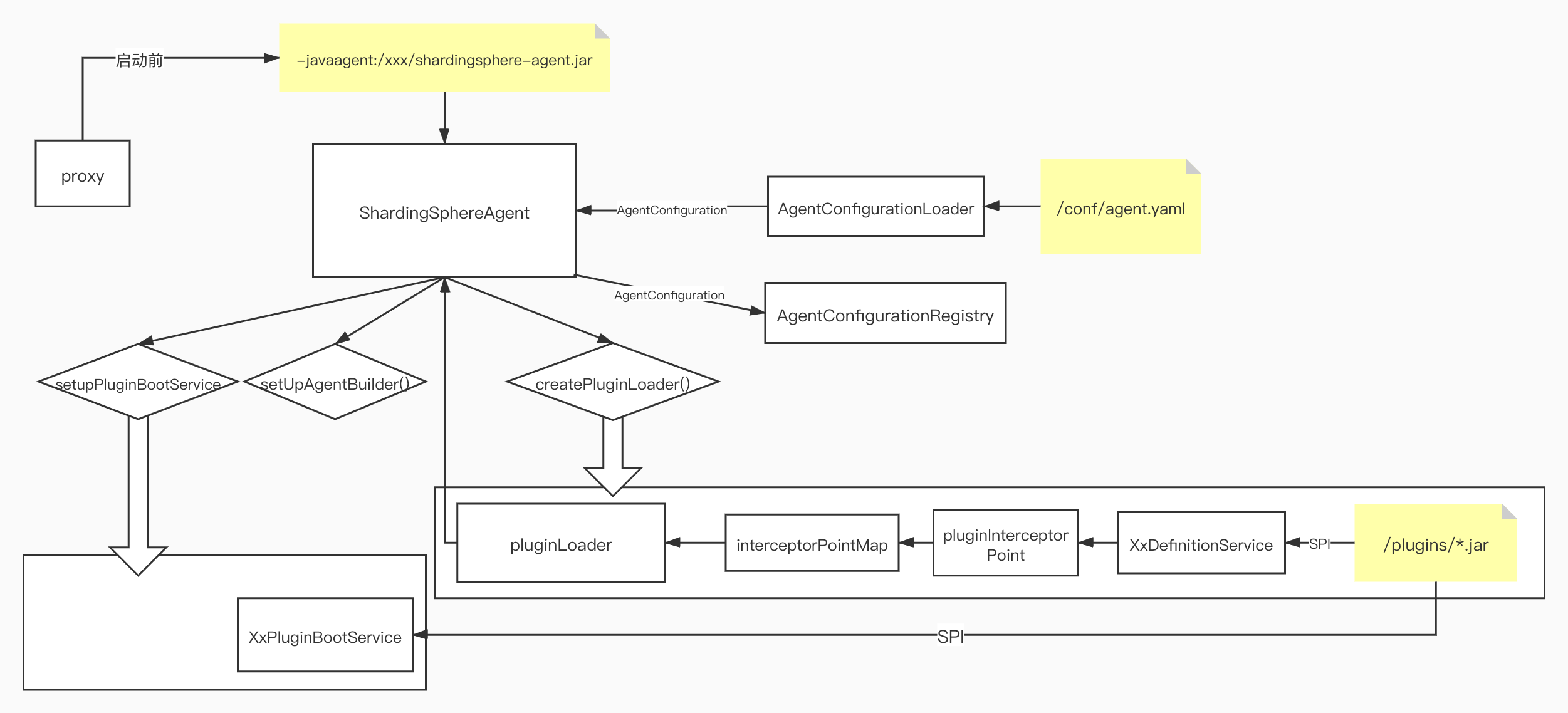ShardingSphere-Agent插件机制梳理
首先fork ss,然后git clone,然后git remote add upstream xxxx,然后git pull upstream master保持本地代码与主仓库一致,然后在项目的根目录下执行
mvn clean install,然后添加虚拟机参数-javaagent:xxx,即可正常使用ss支持的可观察性相关插件。
ShardingSphereAgent类是javaagent参数指定的入口,里面写了premain方法,也就是在proxy启动前运行的。
public static void premain(final String arguments, final Instrumentation instrumentation) throws IOException {
// 1.加载配置文件,默认是在/conf/agent.yaml
AgentConfiguration agentConfiguration = AgentConfigurationLoader.load();
// 2.将agent配置放入注册中心
AgentConfigurationRegistry.INSTANCE.put(agentConfiguration);
// 3.创建PluginLoader并加载所有插件
PluginLoader pluginLoader = createPluginLoader();
// 4.安装AgentBuilder
setUpAgentBuilder(instrumentation, pluginLoader);
// 5.安装PluginBootService
setupPluginBootService(agentConfiguration.getPlugins());
}
大致流程如下图(大图可见:https://img.jooks.cn/img/20210515110232.jpg):

1.加载配置文件
这里跟上一篇文章加载配置文件类似:https://www.jooks.cn/article/55
2.将agent配置放入注册中心
这里的AgentConfigurationRegistry使用了单例模式(这种实现第一次见。。。喵啊),里面其实是一个ConcurrentHashMap,然后put把agent配置放入了map。
3.创建PluginLoader并加载所有插件
private static PluginLoader createPluginLoader() throws IOException {
PluginLoader result = PluginLoader.getInstance();
result.loadAllPlugins();
return result;
}
可以发现这里的PluginLoader也是单例模式(但是实现跟AgentConfigurationRegistry不一样)。
且PluginLoader继承自ClassLoader类。
然后重点看一看result.loadAllPlugins();
public void loadAllPlugins() throws IOException {
// 3.1 从/plugins目录下读取jar文件,包装成File类
File[] jarFiles = AgentPathBuilder.getPluginPath().listFiles(file -> file.getName().endsWith(".jar"));
if (null == jarFiles) {
return;
}
// 3.2 创建pointMap
Map<String, PluginInterceptorPoint> pointMap = Maps.newHashMap();
// 3.3 将配置文件中指定不加载的插件放入一个集合。
Set<String> ignoredPluginNames = AgentConfigurationRegistry.INSTANCE.get(AgentConfiguration.class).getIgnoredPluginNames();
// 3.4 将File逐个包装成PluginJar,然后添加到jars列表中。
try (ByteArrayOutputStream outputStream = new ByteArrayOutputStream()) {
for (File each : jarFiles) {
outputStream.reset();
JarFile jar = new JarFile(each, true);
jars.add(new PluginJar(jar, each));
log.info("Loaded jar {}.", each.getName());
}
}
// 3.5 通过SPI机制加载各个PluginDefinitionService,并把PluginInterceptorPoint放入pointMap
loadPluginDefinitionServices(ignoredPluginNames, pointMap);
// 这里build出来的map是真正immutable的,往里面put东西会报错
interceptorPointMap = ImmutableMap.<String, PluginInterceptorPoint>builder().putAll(pointMap).build();
}
-
从/plugins目录下获取插件的jar文件,包装成File。当前plugins目录内容如下。
这个目录是shardingsphere-agent-distribution模块编译后产生的,为什么会在这里出现这些jar包呢?
因为agent-distribution模块下有一个
shardingsphere-agent-binary-distribution.xml文件,这里面把agent-plugin模块下各个子模块编译好的jar包引入到这里。

-
创建pointMap
这里PluginInterceptorPoint类,其内部类Builder可以通过agent机制替换构造方法、普通方法、静态方法。
-
将配置文件中指定不加载的插件放入一个集合。
-
将File逐个包装成PluginJar,然后添加到jars列表中。
-
通过SPI机制加载各个PluginDefinitionService
private void loadPluginDefinitionServices(final Set<String> ignoredPluginNames, final Map<String, PluginInterceptorPoint> pointMap) {
PluginServiceLoader.newServiceInstances(PluginDefinitionService.class)
.stream()
.filter(each -> ignoredPluginNames.isEmpty() || !ignoredPluginNames.contains(each.getType()))
.forEach(each -> buildPluginInterceptorPointMap(each, pointMap));
}
这里的PluginServiceLoader.newServiceInstances(PluginDefinitionService.class)用到了Java的SPI机制,会去resources/META-INF/services目录下找到接口的全限定名org.apache.shardingsphere.agent.spi.definition.PluginDefinitionService命名的文件,这里以tracing模块的jaeger插件为例,文件内容如下图,里面指出了Service接口的具体实现类。

这样就会把PluginDefinitionService接口的具体实现类JaegerPluginDefinitionService实例化返回。

然后再通过filter方法把配置文件中指定ignore的PluginDefinitionService过滤掉,最后将剩下的服务安装并加入到pointMap中,详细过程如下。
private void buildPluginInterceptorPointMap(final PluginDefinitionService pluginDefinitionService, final Map<String, PluginInterceptorPoint> pointMap) {
AbstractPluginDefinitionService definitionService = (AbstractPluginDefinitionService) pluginDefinitionService;
// install详细见下面,返回一个PluginInterceptorPoint集合
definitionService.install().forEach(each -> {
String target = each.getClassNameOfTarget();
// 如果对一个目标类定义了多个interceptor,那就把这个类的points都汇总到一起
if (pointMap.containsKey(target)) {
PluginInterceptorPoint pluginInterceptorPoint = pointMap.get(target);
pluginInterceptorPoint.getConstructorPoints().addAll(each.getConstructorPoints());
pluginInterceptorPoint.getInstanceMethodPoints().addAll(each.getInstanceMethodPoints());
pluginInterceptorPoint.getClassStaticMethodPoints().addAll(each.getClassStaticMethodPoints());
} else {
pointMap.put(target, each);
}
});
}
这里的install方法代码如下,
public final Collection<PluginInterceptorPoint> install() {
defineInterceptors();
return interceptorPointMap.values().stream().map(PluginInterceptorPoint.Builder::install).collect(Collectors.toList());
}
return 语句是把interceptorPointMap给转化为一个List。
上面的defineInterceptors()方法则是一个抽象方法,由具体的PluginDefinitionService类实现,下面以JaegerPluginDefinitionService为例。
@Override
public void defineInterceptors() {
defineInterceptor(COMMAND_EXECUTOR_TASK_ENHANCE_CLASS)
.aroundInstanceMethod(ElementMatchers.named(COMMAND_EXECUTOR_METHOD_NAME))
.implement(COMMAND_EXECUTOR_TASK_ADVICE_CLASS)
.build();
defineInterceptor(SQL_PARSER_ENGINE_ENHANCE_CLASS)
.aroundInstanceMethod(ElementMatchers.named(SQL_PARSER_ENGINE_METHOD_NAME))
.implement(SQL_PARSER_ENGINE_ADVICE_CLASS)
.build();
defineInterceptor(JDBC_EXECUTOR_CALLBACK_ENGINE_ENHANCE_CLASS)
.aroundInstanceMethod(
ElementMatchers.named(JDBC_EXECUTOR_METHOD_NAME)
.and(ElementMatchers.takesArgument(0, ElementMatchers.named(JDBC_EXECUTOR_UNIT_ENGINE_ENHANCE_CLASS)))
)
.implement(JDBC_EXECUTOR_CALLBACK_ADVICE_CLASS)
.build();
}
这个地方给三个原始方法添加了环绕处理(对方法执行前后进行了具体操作,这里还不懂Jaeger的API,暂时放一放),并把目标类名加入到了interceptorPointMap。
到了这里,所有应该加载的插件的PluginInterceptorPoint都放进了pluginLoader实例的interceptorPointMap中。
4.setUpAgentBuilder
private static void setUpAgentBuilder(final Instrumentation instrumentation, final PluginLoader pluginLoader) {
AgentBuilder agentBuilder = new AgentBuilder.Default().with(new ByteBuddy().with(TypeValidation.ENABLED))
.ignore(ElementMatchers.isSynthetic()).or(ElementMatchers.nameStartsWith("org.apache.shardingsphere.agent."));
agentBuilder.type(pluginLoader.typeMatcher())
.transform(new ShardingSphereTransformer(pluginLoader)).with(AgentBuilder.RedefinitionStrategy.RETRANSFORMATION).with(new LoggingListener()).installOn(instrumentation);
}
这里就是先创建一个忽略 Synthetic 和 以org.apache.shardingsphere.agent.开头的类 的AgentBuilder实例。
然后把agentBuilder实例作用到之前pluginLoader实例里的interceptorPointMap中包含的类名,然后绑定Transform实例,选择RETRANSFORMATION策略,绑定监听器,绑定instrumentation。
可以发现这里最重要的是new ShardingSphereTransformer(pluginLoader),等下再看。
5.setupPluginBootService
private static void setupPluginBootService(final Map<String, PluginConfiguration> pluginConfigurationMap) {
// 1. 启动所有插件的service
PluginBootServiceManager.startAllServices(pluginConfigurationMap);
// 2. 添加jvm关闭钩子,让jvm在关闭前先把service正常关闭
Runtime.getRuntime().addShutdownHook(new Thread(PluginBootServiceManager::closeAllServices));
}
-
先是启动所有插件的service,代码如下,
public static void startAllServices(final Map<String, PluginConfiguration> pluginConfigurationMap) { Set<String> ignoredPluginNames = AgentConfigurationRegistry.INSTANCE.get(AgentConfiguration.class).getIgnoredPluginNames(); for (Map.Entry<String, PluginConfiguration> entry: pluginConfigurationMap.entrySet()) { AgentTypedSPIRegistry.getRegisteredServiceOptional(PluginBootService.class, entry.getKey()).ifPresent(pluginBootService -> { try { if (!ignoredPluginNames.isEmpty() && ignoredPluginNames.contains(pluginBootService.getType())) { return; } pluginBootService.start(entry.getValue()); // CHECKSTYLE:OFF } catch (final Throwable ex) { // CHECKSTYLE:ON log.error("Failed to start service.", ex); } }); } }这里会调用没有被ignore的插件的pluginBootService的start方法。
-
添加jvm关闭钩子,让jvm在关闭前先把service正常关闭,代码如下,
public static void closeAllServices() { AgentTypedSPIRegistry.getAllRegisteredService(PluginBootService.class).forEach(each -> { try { each.close(); // CHECKSTYLE:OFF } catch (final Throwable ex) { // CHECKSTYLE:ON log.error("Failed to close service.", ex); } }); }
1和2中的start和close都由具体的XxPluginBootService实现。
ShardingSphereTransformer
在setUpAgentBuilder方法里面设置了agent的transformer和listener,这里来详细看看。
ShardingSphereTransformer
@Override
public Builder<?> transform(final Builder<?> builder, final TypeDescription typeDescription, final ClassLoader classLoader, final JavaModule module) {
if (pluginLoader.containsType(typeDescription)) {
Builder<?> result = builder;
result = result.defineField(EXTRA_DATA, Object.class, Opcodes.ACC_PRIVATE | Opcodes.ACC_VOLATILE)
.implement(AdviceTargetObject.class)
.intercept(FieldAccessor.ofField(EXTRA_DATA));
PluginInterceptorPoint pluginInterceptorPoint = pluginLoader.loadPluginInterceptorPoint(typeDescription);
result = interceptorConstructorPoint(typeDescription, pluginInterceptorPoint.getConstructorPoints(), result);
result = interceptorClassStaticMethodPoint(typeDescription, pluginInterceptorPoint.getClassStaticMethodPoints(), result);
result = interceptorInstanceMethodPoint(typeDescription, pluginInterceptorPoint.getInstanceMethodPoints(), result);
return result;
}
return builder;
}
这里就是设置拦截点。